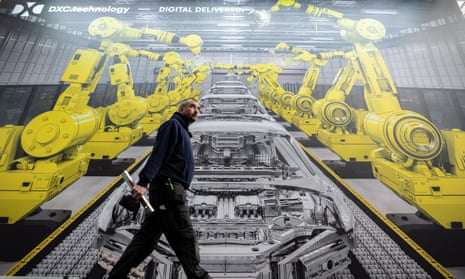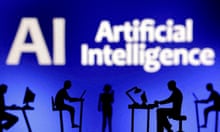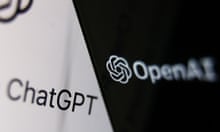As artificial intelligence spreads rapidly across America’s economy, there’s a lively debate about how it will transform the future of work. What many people fail to realize is that AI has already changed millions of workers’ jobs – often for the worse.
At Amazon, some warehouse and delivery drivers complain that AI-driven bots have fired them without any human intervention whatsoever. At some companies, surveillance apps track how much time workers spend in trips to the bathroom, with some workers protesting that the time limits are too strict.
Many corporations gather information about their employees through webcams, keyboards, internet activity and phone logs, and that can include private information about workers’ political opinions, sexual orientation, union activity and even their emotions and mental state. Inside many call centers, AI tools monitor the calls that agents make, and based on factors like the agent’s or customer’s tone of voice, those tools often send messages to an agent’s computer, directing them to talk with more empathy or energy.
And then there are the forecasts that AI will wipe out millions of jobs. The McKinsey Global Institute estimates that by 2030, tasks that account for up to 30% of the hours now worked across the US could be automated, and that AI will push 12 million American workers out of their jobs. Goldman Sachs predicts that AI will disrupt 300m jobs worldwide by 2030.
C-suite executives can’t wait to deploy more AI in their offices, warehouses and factories, but many workers, white-collar and blue-collar alike, worry that AI will mean only bad news for them: more stress, surveillance, and speed-ups, and more layoffs, too. It doesn’t have to be that way.
In Germany and several other European countries, workers often have a voice in how their employers roll out and use artificial intelligence. German law requires that companies notify their works councils (worker-management committees that exist in most German workplaces) in advance about any plans to introduce AI. Those councils often then discuss how to use AI, typically with an eye to having it complement workers and make them more productive, instead of replacing them.
Virginia Doellgast, a Cornell University expert on AI and work, told me that the German model, with its works councils and strong unions, leads to less employee resistance to AI, smoother rollouts of AI-related technologies, and increased productivity that benefits companies and workers alike.
But in the United States, a country where workplace decisions are typically top-down with employees having little or no input, workers often feel like victims and guinea pigs when it comes to AI. Indeed, many workers don’t even know when their employers are using AI to surveil them or speed up their jobs.
Labor leaders wish that US workers could have a strong voice in how AI is introduced and implemented, but that’s wishful thinking in a nation where just 6% of workers in private industry are in labor unions. At unionized workplaces, but not non-union ones, employees have a right not only to negotiate about AI when it substantially affects working conditions, but also to push for protections against some of AI’s worst effects. Hollywood’s writers’ and actors’ unions won important protections on AI in the negotiations that settled their lengthy strikes last year.
One labor leader told me that unions certainly recognize that new technologies can increase productivity and overall prosperity. But he added that AI-related technologies often “speed up the work, deskill the work, make workplaces more stressful and make jobs more demanding”.
At some companies, AI-powered tools keep tabs on whether employees meet their production quotas, and those tools sometimes automatically increase the quotas of employees who regularly meet them. With employers increasingly using AI to screen résumés, AI has faced complaints about discriminating against older applicants, women, people of color and workers with disabilities. At many call centers, AI-powered apps review the transcripts of agents’ conversations with customers and sometimes give warnings or demerits to agents for straying too far from the assigned script.
Some economists warn that if corporations can roll out AI with little input from workers, then AI will increase production and profits for corporations, with few or any gains for workers – all while increasing the nation’s overall income inequality. Workers will suffer from speed-ups, stress and layoffs, and society at large may have to finance tens of billions of dollars in unemployment insurance, health coverage and perhaps food and rent assistance for many who lose their jobs to AI.
To minimize AI’s negative effects on America’s 160 million workers, there are many things government, labor and business should do. Government should require companies to notify their workers when they’re using AI tools to monitor them.
Recognizing that workers aren’t in a position to assess the downsides of AI, Liz Shuler, president of the AFL-CIO union federation, has called for having a government agency vet AI technologies to determine whether they’re harmful to workers – just as the FDA vets drugs to make “sure drugs don’t kill people before they’re put out into the world”.
With AI threatening to cause large-scale layoffs, the government should create incentives for employers to embrace four-day, even three-day workweeks to spread the work around and minimize layoffs. For example, if AI makes a 1,000-employee company consider laying off 200 people, that company could avoid layoffs by shifting its 1,000 employees to four-day workweeks.
Labor unions need to snap to attention on AI and educate workers, both union and non-union, about AI’s harms and benefits – it can mean more invasiveness, but also increase productivity and hopefully workers’ wages, too. Unions should also educate workers about how to press their employers to reduce AI’s harms and to share the fruits of AI so that workers, and not just shareholders, benefit from the increased productivity and profits it produces. (The AFL-CIO’s Technology Institute is already doing some of this educating.)
Unions should press companies to use AI in ways that complement rather than displace workers, and that means pushing for enhanced training to help employees work with AI. Unions should of course keep up their efforts to unionize tech workers.
As for business, Michael Richards, policy director at the US Chamber of Commerce’s technology engagement center, said that “while there are clear benefits” to AI, “there are legitimate concerns” surrounding the technology. Richards said companies “recognize that engaging in an inclusive dialogue about using new technologies is critical”. Such a dialogue could reduce workers’ distrust of AI and encourage employee input, for instance, about ways to tweak AI tools to have them work more efficiently alongside workers.
There’s little doubt that AI will bring big changes, good and bad, to America’s workplaces. To reduce AI’s harmful effects, President Biden should create a panel of government, union and business officials, much like the tripartite boards that President Franklin Roosevelt created to maximize arms production during the second world war. This new panel should make recommendations about how best to use AI in America’s workplaces, all with the goal of maximizing AI’s benefits for the nation and sharing the gains from AI while minimizing the pain for workers.
Steven Greenhouse, a senior fellow at the Century Foundation, is an American labor and workplace journalist and writer










